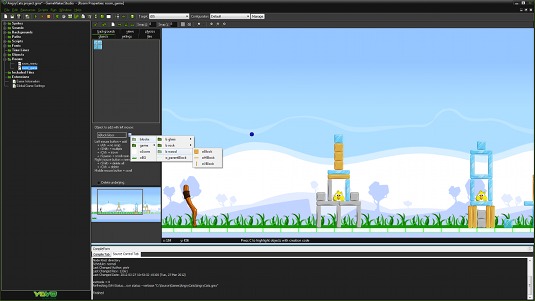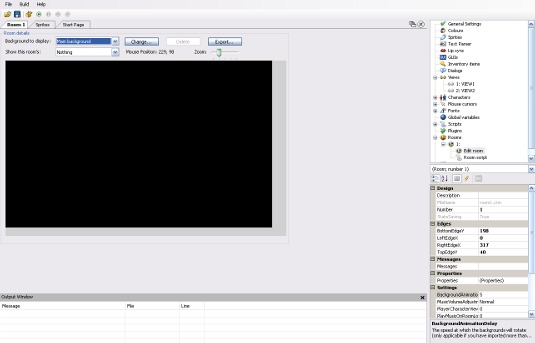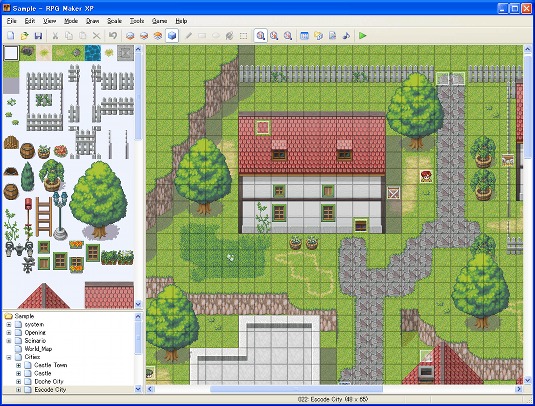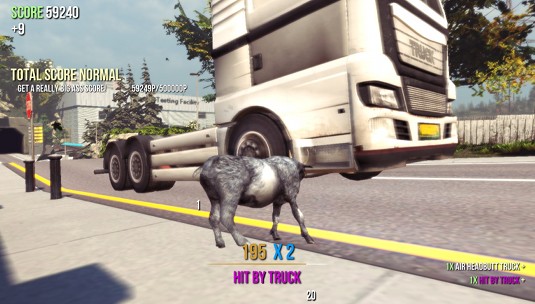5 fantastic tools for making your own video game
Got a great idea for a game? Here are five powerful tools that could make your gaming dream a reality.
You don't need a huge budget, a massive team, or a deal with a publishing giant to make a hit game these days: just a computer and an idea. The indie revolution is making millionaires out of bedroom game designers, and anyone can learn to use the tools they built their games with.
No coding experience? Never made a game before? It doesn't matter. The software here is accessible, intuitive, and supported by vast communities of like-minded developers who can help you get your idea out of your head and onto hard drives. Could you be the next indie success story?
01. GameMaker Studio

This is a powerful development suite used mainly for 2D games. It uses both an intuitive drag and drop interface, and its own C-based scripting language, GML. You can create most game types in GM, from top-down racers and RPGs to point-and-click adventures and classic platformers. It has support for shaders, real-time lighting, physics, particles, and more, all through GML.
You can make simple games without entering a line of code. Scores, experience points, menus, AI, and pretty much everything can be achieved by dragging and dropping simply labeled icons. You won't need any external graphics software either, as it has its own built in, complete with animation tools.
As your idea gets more complex you'll have to start using code, but there are thousands of YouTube tutorials to help, and you can solve most problems with a quick Google. If those fail, ask for help on the official programming Q&A forum and you'll get an answer quickly from the helpful community. This is a great place to start for beginners, even if you have no prior coding experience.
Success stories:

This violent action game from Swedish studio Dennaton Games was released in 2012 to great acclaim. Its vivid graphics, fast-paced gameplay, and stylish '80s atmosphere were all achieved in GameMaker, and it was created by just two people. It's since been ported to the PlayStation Vita.

Dutch studio Vlambeer created this addictive arcade shooter in GameMaker, which received critical acclaim and an 80 rating on Metacritic - better than most triple-A titles manage. Publisher Devolver Digital picked both this and Hotline Miami up, making them available on Steam.
Daily design news, reviews, how-tos and more, as picked by the editors.
02. Unity

If you want to make a 3D game, Unity is a good place to start. It's a lot more complicated than GameMaker, but also has a vast amount of online support. It can also be used to make 3D games, and games built in the engine can be run on PCs, iPhones, Android, web browsers, and a variety of other platforms. Unity is the easiest way to make 3D games for a novice.
Unity is versatile enough that you can make basically any game in it. It's even possible to make 2D games. The engine is used by both indie developers and triple-A publishers. The basic version is free and you're able to sell games made in it royalty free, so long as they make less than $100,000.
The free version is fine for beginners, but you may want to consider upgrading to Unity Pro if your project gets more ambitious. Some coding knowledge will help in the long run, but like all the software here, plentiful tutorials can be found online to teach you the basics. The Unity suite can also be used to make games that support the Oculus Rift virtual reality headset.
Success stories:

This indie puzzle-platformer was created by just one person, Mike Bithell. He used the game to teach himself Unity, and although it uses simple blocks for its characters, rich art, a professional voiceover by TV's Danny Wallace, and a charming story brought them to life.

This was one of the most celebrated indie games of 2013. It sees you exploring a richly detailed house, uncovering clues, and following a story to find out where your missing family is. It's touching, well-written and atmospheric, and was built entirely in the Unity engine.
03. Adventure Game Studio

With this suite you can create adventure games in the mould of popular LucasArts games like Monkey Island and Full Throttle. This means it's not ideal for games with mechanics other than point-and-click puzzles, but is a great platform for showcasing story, dialogue, and puzzle design. No coding knowledge is necessary, but is an optional tool to make your game more sophisticated.
You can put together a simple adventure game in a weekend with AGS. It handles things like dialogue and pathfinding so you can focus on writing and art. The biggest limitation is that you can only make games for Windows, so you won't be able to get your games on mobile platforms.
Adventure Game Studio is completely free and has no limitations on how you can use games made with it. This means that if you make something with it, and sell copies, you'll be making pure profit. It's showing its age, though. If you want to make an adventure game, you can recreate the mechanics in something like Unity, but with much more modern visuals.
Success stories:

An atmospheric cyberpunk adventure game by Wadjet Eye Games, whose successful legacy of games were built entirely in Adventure Game Studio. Other hits include the Blackwell series, The Shivah, and Resonance. They're worth playing if you're looking for inspiration.

This comedy point-and-click adventure was made in just a few months, mostly in its creators' spare time. Its basic artwork is lifted by entertaining dialogue and amusing set-pieces, and it turned a profit despite being developed for absolutely nothing, and received some critical acclaim.
04. RPG Maker

This program is designed with Japanese-style RPGs in mind, and comes complete with basic graphics sets, so you can put something together without creating any assets at all. Still, some people have managed to stretch the engine to make shooters and adventure games. But it's best suited to top-down role-players in the style of SNES games like Chrono Trigger and Final Fantasy.
RPG Maker has its own scripting language based on Ruby, but it's not essential to making a game. You can create everything from dialogue, combat, exploration, and cut-scenes using the simple Windows-based interface. It's designed with novices in mind, so is ideal for entry level development.
But if your idea is more specific or complex, and not rooted in RPGs, then you might want to use something more diverse and powerful like GameMaker. While there's a lot you can do in RPG Maker, it is, like Adventure Game Studio, best suited to a single type of project.
Success stories:

While it has the visual style of SNES-era RPGs, this beautiful and well-written game is mostly story-led. It was released to huge critical acclaim, and praised for its sad, affecting story and music. It's available on Steam, and is regularly a top-seller when the service has its popular seasonal sales.

This was the first game made in RPG Maker to be released commercially. It has dungeons, puzzles, lots of dialogue, and was reviewed well when it was released in 2008. Unlike To the Moon, this game sticks closely to the J-RPG format, which will have made developing it easier.
05. Unreal Development Kit

The Unreal engine has been used in thousands of games, ranging from indies to massive, big budget productions. It's a flexible enough tool that you can make a modern classic like BioShock with a huge team, or a small scale game on your own. But it's the most difficult to use in our list, and you'll have a harder time learning the basics than with something like GameMaker or Unity.
The engine is great for lighting, large levels and physics, but you'll need a team, or at least a partner, to really get the best out of it. You can make a small-ish game with basic mechanics in 6-7 months, but you'll need to dig into the documentation and learn coding to create advanced gameplay.
The Unreal gets its name from Epic's Unreal series of games, so it's finely tuned for FPS games and third-person shooters. But it is possible to make almost any kind of 3D game in it. There are tutorials all over the internet for UDK, as well as some published books. If you're pursuing game development as a serious career, this might be worth learning in the long run.
Success stories:

You don't have to use UDK to aim for photorealism. A bold or simple art style is often a good way for an indie dev to get around the hurdle of creating lots of expensive assets. Antichamber's strong visuals are backed up with clever puzzles and was made by a single dev.

Videos of this slapstick physics playground quickly spread around YouTube, and it eventually became the best-selling game on Steam when it was released. The developers intentionally left most of the bugs in for comedy value. Just don't expect an accurate simulation of being a goat.
Words: Andy Kelly

The Creative Bloq team is made up of a group of art and design enthusiasts, and has changed and evolved since Creative Bloq began back in 2012. The current website team consists of eight full-time members of staff: Editor Georgia Coggan, Deputy Editor Rosie Hilder, Ecommerce Editor Beren Neale, Senior News Editor Daniel Piper, Editor, Digital Art and 3D Ian Dean, Tech Reviews Editor Erlingur Einarsson, Ecommerce Writer Beth Nicholls and Staff Writer Natalie Fear, as well as a roster of freelancers from around the world. The ImagineFX magazine team also pitch in, ensuring that content from leading digital art publication ImagineFX is represented on Creative Bloq.
